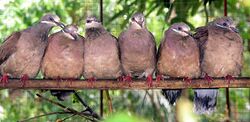Biology:Brown dove
| Brown dove | |
|---|---|

| |
| White-eared brown dove (P. leucotis) | |
| Scientific classification | |
| Domain: | Eukaryota |
| Kingdom: | Animalia |
| Phylum: | Chordata |
| Class: | Aves |
| Order: | Columbiformes |
| Family: | Columbidae |
| Subfamily: | Treroninae |
| Genus: | Phapitreron Bonaparte, 1854 |
| Type species | |
| Columba leucotis[1] Temminck, 1823
| |
Brown doves are members of the genus Phapitreron in the pigeon family. Their common name refers to their overall brown coloration. They are endemic to the Philippines . All brown doves are tree-dwellers, but the different species occupy different types of wooded habitats; some are more restricted to old-growth forest while other make use of secondary forest and other woodland. Their main diet is fruit. They tend to be solitary in their habits and can be elusive. Some species in this genus have conspicuous black and white stripes on their faces and iridescent neck feathers. Males and females look alike.
Taxonomy
The genus Phapitreron was introduced in 1854 by the French naturalist Charles Lucien Bonaparte for the white-eared brown dove (Phapitreron leucotis).[2][3] The genus name Phapitreron combines the genus name Phaps introduced by the English naturalist Prideaux John Selby in 1835 for the bronze-wing pigeons with the Ancient Greek trērōn meaning "pigeon".[4]
The genus contains four species:[5]
- White-eared brown dove (Phapitreron leucotis)
- Amethyst brown dove (Phapitreron amethystinus)
- Tawitawi brown dove (Phapitreron cinereiceps)
- Mindanao brown dove (Phapitreron brunneiceps) – split from the Tawitawi brown dove
Some ornithologists have split two of the above species:[6]
- Buff-eared brown-dove (Phapitreron nigrorum) – split from the white-eared brown dove[7]
- Short-billed brown-dove (Phapitreron brevirostris) – split from the white-eared brown dove[8]
- Cebu brown-dove (Phapitreron frontalis) – split from the amethyst brown dove; listed as an EDGE species by the Zoological Society of London[9] and Critically Endangered by the IUCN.[10]
- Grey-breasted brown-dove (Phapitreron maculipectus) – split from the amethyst brown dove[11]
References
- ↑ "Columbidae". The Trust for Avian Systematics. https://www.aviansystematics.org/4th-edition-checklist?viewfamilies=66.
- ↑ Bonaparte, Charles Lucien (1854). "Coup d'oeil sur les pigeons" (in French). Comptes Rendus Hebdomadaires des Séances de l'Académie des Sciences 39: 869–880 [879]. https://www.biodiversitylibrary.org/page/2820060.
- ↑ Peters, James Lee, ed (1937). Check-List of Birds of the World. 3. Cambridge, Massachusetts: Harvard University Press. p. 23. https://www.biodiversitylibrary.org/page/14477738.
- ↑ Jobling, James A. (2010). The Helm Dictionary of Scientific Bird Names. London: Christopher Helm. p. 310. ISBN 978-1-4081-2501-4. https://archive.org/details/helmdictionarysc00jobl_997.
- ↑ Gill, Frank; Donsker, David; Rasmussen, Pamela, eds (2020). "Pigeons". IOC World Bird List Version 10.1. International Ornithologists' Union. https://www.worldbirdnames.org/bow/pigeons/. Retrieved 16 March 2020.
- ↑ Collar, N.J. (2011). "Species limits in some Philippine birds including the Greater Flameback Chrysocolaptes lucidus". Forktail 27: 29–38. https://static1.squarespace.com/static/5c1a9e03f407b482a158da87/t/5c211d4d4fa51a4c897b3a4b/1545674062184/Greater-Flameback.pdf.
- ↑ BirdLife International (2016). "Phapitreron nigrorum". IUCN Red List of Threatened Species 2016: e.T22727834A94963146. doi:10.2305/IUCN.UK.2016-3.RLTS.T22727834A94963146.en. https://www.iucnredlist.org/species/22727834/94963146.
- ↑ BirdLife International (2016). "Phapitreron brevirostris". IUCN Red List of Threatened Species 2016: e.T22727841A94963314. doi:10.2305/IUCN.UK.2016-3.RLTS.T22727841A94963314.en. https://www.iucnredlist.org/species/22727841/94963314.
- ↑ "Cebu Brown-dove". http://www.edgeofexistence.org/species/cebu-brown-dove/.
- ↑ BirdLife International (2021). "Phapitreron frontalis". IUCN Red List of Threatened Species 2021: e.T60543516A205992046. doi:10.2305/IUCN.UK.2021-3.RLTS.T60543516A205992046.en. https://www.iucnredlist.org/species/60543516/205992046. Retrieved 5 December 2023.
- ↑ BirdLife International (2017). "Phapitreron maculipectus". IUCN Red List of Threatened Species 2017: e.T60543526A110865806. doi:10.2305/IUCN.UK.2017-1.RLTS.T60543526A110865806.en. https://www.iucnredlist.org/species/60543526/110865806.
- Gibbs, David; Barnes, Eustace; Cox, John (2001). Pigeons and Doves: A Guide to the Pigeons and Doves of the World. Yale University Press. pp. 421–424. ISBN 0-300-07886-2.
Wikidata ☰ Q579965 entry
 |

